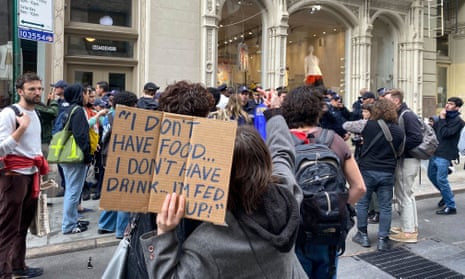Pressure was mounting on police, prosecutors and the New York mayor, Eric Adams, on Thursday as protesters, advocates and even Congresswoman Alexandria Ocasio-Cortez criticized the lack of action over the death of Jordan Neely, a 30-year-old Black man and Michael Jackson impersonator who was placed in a chokehold by another subway rider.
Adams has heightened police presence in subway stations in an attempt to curtail crime, while endorsing involuntarily hospitalizing people experiencing homelessness with mental illness and using police to remove people suffering from mental illness from subway stations.
But even as Adams touts future investments in mental healthcare, the city has reduced services for those experiencing such challenges.
Advocates argued that the circumstances surrounding Neely’s life and death – his struggles with homelessness, food insecurity and mental health struggles – reflected longstanding failures to provide social services to impoverished New Yorkers.
The killing happened on Monday afternoon. A 24-year-old former Marine, whose name and identity was not immediately publicly released, held Neely in a chokehold while other riders restrained him on the floor of a train, a four-minute video captured by a freelance journalist shows.
Police questioned the rider who put Neely in a hold and placed him in custody then released him the same day.
On Wednesday, the city medical examiner confirmed that Neely, who witnesses say was yelling at other riders on an F train heading to Manhattan, died from compression to the neck.
His death was ruled a homicide.
As of Thursday morning, no arrests had been made and no charges had been filed.
That response sparked protests at subway stations and on the streets in recent days over what they say was an act of vigilantism that killed a man experiencing homelessness and mental health challenges.
The New York governor, Kathy Hochul, called the attack “deeply disturbing”.
She also told Spectrum News NY1 that a broader context of “people who are homeless in our subways, many of them in the throes of mental health episodes” factored into Neely’s case, adding there are “consequences for behavior”.
Investigations, however, have established that deaths and killings among homeless people have surged in recent years. In 2022, for example, an investigation by the Guardian and the University of Washington established that in 20 US urban areas in the five years ending in 2020, deaths among people living without housing rose by 77%.

Homelessness advocates and city officials condemned Neely’s death and the city’s inadequate response to people experiencing mental health crises and homelessness.
Christian Smalls, a key leader behind the successful unionization of Amazon workers in Staten Island, said there was no justification for “choking out any homeless person” and likened Neely’s death to the murder of George Floyd. Floyd, who was Black, was killed by a white Minneapolis police officer who knelt on him in May 2020, triggering a summer of global protests against police brutality.
Smalls said he often saw Neely on his commute to the Amazon warehouse before the Covid pandemic.
“I’ll never forget enjoying seeing him dance and sing MJ for the people,” Smalls tweeted.
Legal experts told the New York Times police and prosecutors must decide whether the chokehold that killed Neely was justified. Specifically, they must figure out if the rider who used the chokehold believed he or other riders feared for their safety.
New York law allows a person to use force if the person “reasonably believes” they face the “imminent use of unlawful physical force” by another person. Deadly force can only be justified if the person “reasonably believes that such other person is using or about to use deadly physical force”.
A spokesperson for Manhattan district attorney, Alvin Bragg, told the Associated Press: “As part of our rigorous ongoing investigation, we will review the medical examiner’s report, assess all available video and photo footage, identify and interview as many witnesses as possible, and obtain additional medical records.”
In an initial statement, Adams said “any loss of life is tragic”, adding “we do know there were serious mental health issues in play here” and touting his administration’s “record investments in providing care to those who need it”.
Elected officials from city councilors to the comptroller, Brad Lander, and Ocasio-Cortez, a New York congresswoman, condemned Neely’s death.
Lander said: “NYC is not Gotham. We must not become a city where a mentally ill human being can be choked to death by a vigilante without consequence. Or where the killer is justified and cheered.”
Ocasio-Cortez, who said Neely was “murdered”, tweeted: “Jordan was houseless and crying for food in a time when the city is raising rents and stripping services to militarize itself.”
The congresswoman also said Adams’s statement was a “new low” from an administration “trying to cut the very services that could have helped” Neely.
On CNN, Adams said it was not “very responsible” for elected officials to comment on the case and the investigation should run its course.
A later statement from Adams’s office said Neely “should still be alive [as] any possible mental health challenges that Jordan may have been experiencing were no reason for his life to be taken”.
The mayor added that the police’s initial response represented the “double standard Black people and other people of color continue to face”.
“There must be accountability for his killing,” the statement said. “[A] thorough investigation by the Manhattan district attorney that accounts for the facts and these realities is critical.”
